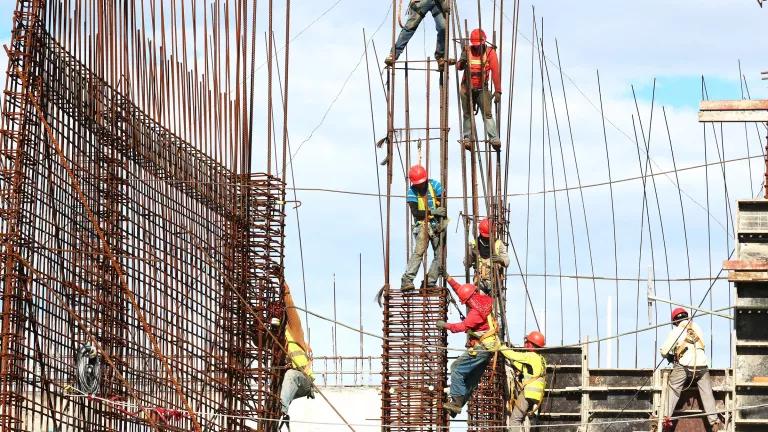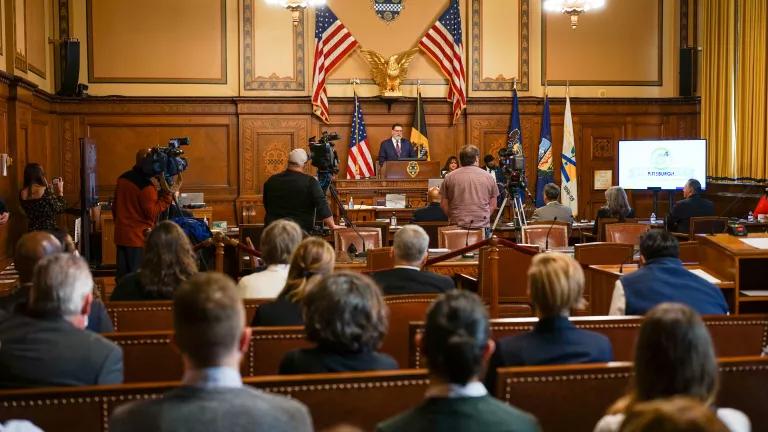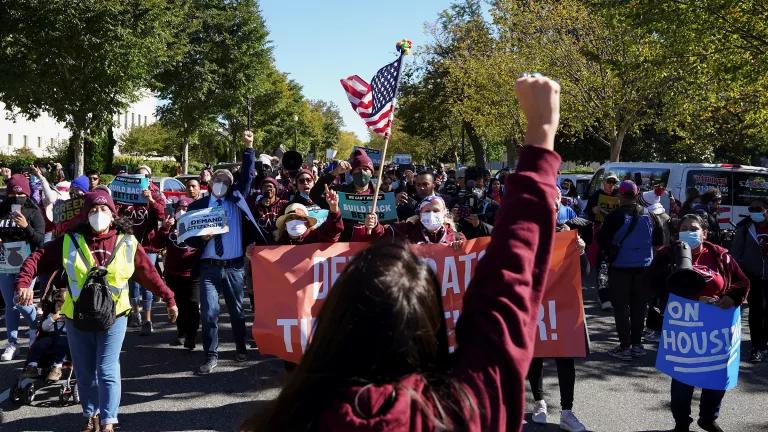Maria Exposed Problems With U.S. Disaster Policy
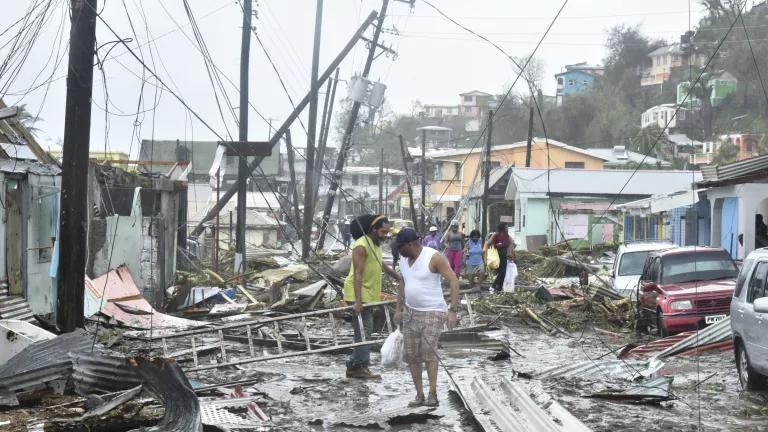
When Hurricane Maria made landfall in Puerto Rico and the U.S. Virgin Islands last year, it put on full display two big problems with how our nation deals with disasters. The first problem is the preference for reacting after a disaster happens, rather than remedying vulnerabilities before a storm or hurricane becomes a disaster. The second problem is that the Federal Emergency Management Agency (FEMA) does not have the capacity to do its mission, much less handle four catastrophic disasters simultaneously, especially when one devastates islands a thousand miles away from the mainland.
Cumulative damages in 2017 from weather and climate-related disasters in the United States totaled $306 billion, the most expensive disaster year in U.S. history and, it turns out, the third-warmest year on record. Hurricane Maria was the deadliest of the year’s tragic storms.
Federally declared disasters and the damages caused by climate-fueled disasters have been steadily increasing. The Government Accountability Office (GAO) estimated that between 2005 and 2014, the federal government obligated $277 billion for disaster assistance programs. In 2017 alone, Congress appropriated $120 billion in supplemental funding and more came from FEMA's Disaster Relief Fund to address three major hurricanes and fires in the Western U.S.
Welcome to the new normal.
At this juncture, the biggest mistake we can make is to treat 2017 as an aberration and assume we won’t experience more years with multiple simultaneous disasters. Because of our collective failure to reduce the carbon emissions that cause climate change, we’ve all but guaranteed what the future has in store.
What Went Wrong In Hurricane Maria?
FEMA has been heavily criticized for its slow and disorganized response to Hurricane Maria. At the same time, President Trump has largely avoided criticism, even when making shocking unsubstantiated claims about how many people lost their lives in Puerto Rico as a result of Hurricane Maria. My colleague Mekela Panditharatne made it clear in a New York Times op-ed that President Trump doesn’t get a pass for what happened with Maria.
Multiple things went wrong in Puerto Rico. Puerto Rico was in the midst of a financial crisis well before Maria hit, which contributed to multiple systemic failures (I recommend reading Jeff Goodell’s recent article in Rolling Stone to learn more). But many of the problems around the disaster response itself stem from how thinly stretched FEMA was by the multiple disasters that occurred in 2017 and the administration’s failure to remedy the situation.
According to FEMA’s After-Action Report, the agency requires 6,630 staff to respond to what it calls a “Level 1” disaster, the most serious type of incident, and its plans call for it to handle two Level 1 disasters in a single year. Between 1997 and 2014, FEMA had a total of ten Level 1 disasters. In 2017 it had five Level 1 disaster operations underway simultaneously in Texas, Florida, California, Puerto Rico, and the U.S. Virgin Islands. The agency quickly found itself without the capacity to respond adequately to Hurricane Maria and was shorthanded in the other disaster zones as well.
In none of the five disaster operations did FEMA staff deployments reach the target of 6,630 staff. As Harvey, Irma, and Maria made landfall between August 25 and September 20, progressively fewer FEMA staff were available to deploy. Staff also had to be redeployed from one disaster to the next.
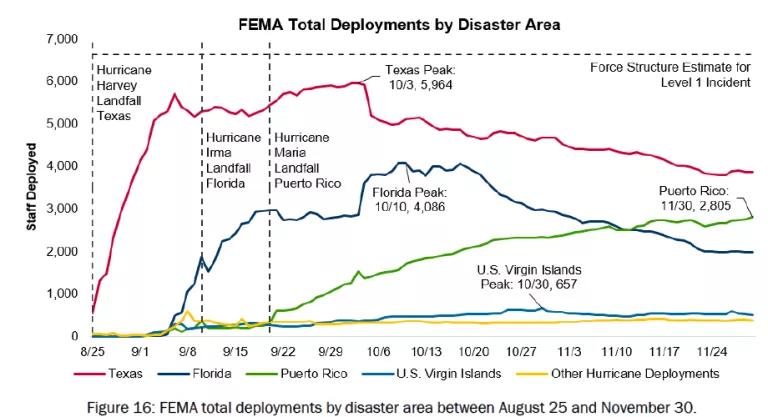
One unanswered question is why more FEMA staff were not already in place in Puerto Rico and the U.S. Virgin Islands when Hurricane Maria made landfall, given that Hurricane Irma had caused enormous damage there two weeks earlier. As the graph above shows, the number of FEMA staff deployed to those islands for Irma were far lower than the staff allocated to Florida, a situation that warrants further investigation.
Of the staff FEMA did deploy, the Government Accountability Office (GAO) found that 54 percent were not rated as “qualified,” meaning they had not received the necessary training to perform their specific roles. FEMA fully acknowledges in its After-Action Report the need to invest more in training the staff who will deploy to a disaster. Unfortunately, FEMA may find it harder to address this shortcoming, because of the Trump administration’s recent move to divert $9.8 million in FEMA funding for training and “response and recovery” operations to U.S. Immigration and Customs Enforcement.
Complicating matters further, Hurricane Maria’s damage far exceeded FEMA’s planning assumptions for a disaster in Puerto Rico, as the graphic below from FEMA’s After-Action Report illustrates.
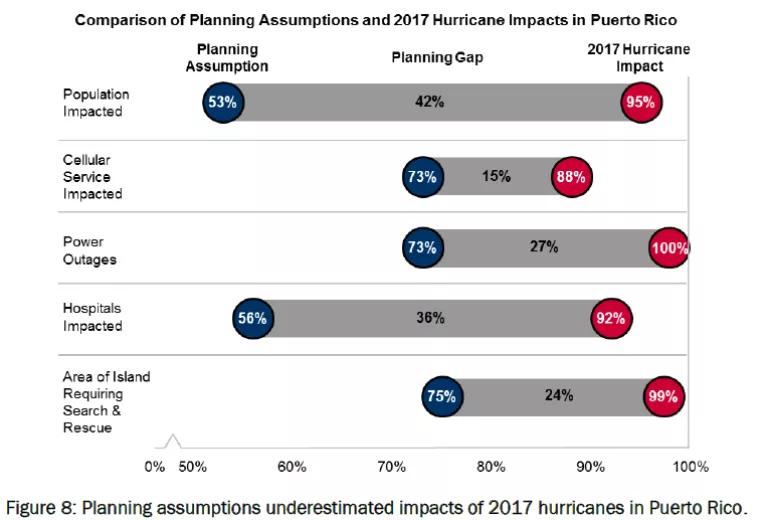
Just as many local and state governments have been overwhelmed by the magnitude of recent disasters that surpassed historical experience, FEMA found itself responding to a disaster that it had never anticipated.
One year after Maria struck Puerto Rico and the U.S. Virgin Islands, Hurricane Florence has dealt a blow to the Carolinas, repeating a deadly and damaging cycle. Millions of people are once again affected, many of whom will be displaced for weeks and quite possibly longer. Tens of thousands of homes are flooded and even more are without power. And this comes just two years after these same families were hit by Hurricane Matthew, from which they were a still recovering.
Florence and Maria are different storms taking place under very different circumstances. FEMA’s immediate response to Florence has not encumbered by two previous hurricanes, nor are the Carolinas located one thousand miles away from the mainland.
But two main problems still persist and must be addressed. The nation needs to break the habit of simply responding to natural disasters by throwing massive amounts of money and effort at them after-the-fact. We know our infrastructure systems are aging or not able to withstand a major storm event. We know which homes are already in harm’s way. We know that damaging storms are more likely to occur. We know sea level rise is happening. We know that risks are increasing and our vulnerabilities are increasing with them. We need to shift our focus to making our communities more resilient and better prepared before future storms occur, something the GAO has recommended and that FEMA itself recognizes. That must be reflected in how we budget for disasters, resilience, and rebuilding efforts, it must be reflected in local decisions about where we build and how we build, and in many other decisions.
And to do this we also need a Federal Emergency Management Agency that can better support that national effort. FEMA usually only comes to people’s attention after a disaster takes place, but a big part of their mission is focused on helping communities avoid the next disaster, which communities also need to take more responsibility for. You wouldn’t know that from FEMA's operations and budget, which is skewed heavily towards disaster response. It's worth noting that FEMA is currently overseeing 732 open disaster declarations dating back to 1998 (open declarations means that federal disaster aid has not been expended and the project officially closed).
FEMA needs to step up in a way it hasn’t been asked to do in the past. But that requires much more than a shift in the agency’s priorities; it requires Congress and the President to give FEMA the resources, staffing, and funding necessary to help the nation prepare, become more resilient, and be able to weather future storms. We already know what failure to do so looks like. We have been watching it in the aftermath of Hurricane Maria.

